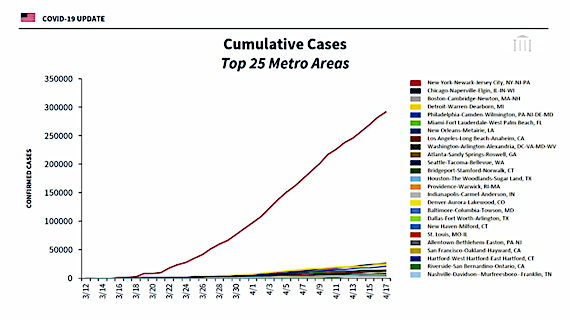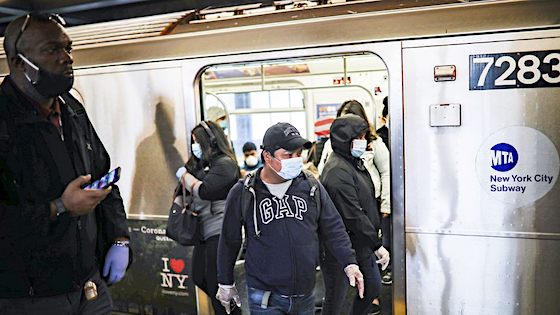Superficially, one would say: of course it did. New York is by far the worst center of Wuhan virus infection in the U.S. The extent to which the New York metropolitan area drives U.S. COVID-19 statistics was documented by Matt Margolis at PJ Media. Currently the U.S. ranks eighth among countries in COVID fatalities per capita. But if we treat New York and its environs as a country, it is easily the world’s hottest COVID hot spot, with per capita fatalities double those in Spain and more than double those in Italy, while the rest of the U.S.–everything except New York City–doesn’t make the top 10.
This chart compares cumulative Wuhan flu cases in America’s top 25 metro areas. The top line is New York; the others are all clustered far below. So the problem isn’t an urban issue per se, although all cities obviously have higher population density than rural areas. Click to enlarge:
It would be easy to blame New York City’s disastrous performance on incompetent leadership from Governor Andy Cuomo, Mayor Bill DeBlasio, and the city’s leadership team generally. But there are specific reasons why New York poses larger challenges than any other metro area, as I noted here. It is considerably more densely populated than any other U.S. city. More important, it has ten times the public transportation ridership of any other city, overwhelmingly on subways. For obvious reasons, public transportation is suspect number one when we are looking for virus transmission sites.
A recently-published academic paper concludes that the subways have indeed been New York’s worst virus problem:
New York City’s multitentacled subway system was a major disseminator – if not the principal transmission vehicle – of coronavirus infection during the initial takeoff of the massive epidemic that became evident throughout the city during March 2020.
The authors reach this conclusion in part by correlating a decline in new COVID cases between March 31 and April 7 with drops in subway ridership between March 2 and March 16 that varied from 33% (Staten Island) to 65% (Manhattan). No surprise there. What many will find surprising is that the subways, an obvious incubator of disease, have still not been closed down altogether. The study’s authors note that by the end of March–after the cows were out of the barn–subway ridership was down by 90%. But the subways are still operating and still spreading disease. Local authorities cut down on the number of trains, but the authors point out that this only made matters worse:
The Metropolitan Transit Authority’s decision to cut back its train service to accommodate the reduced demand may have indeed helped to shore up the agency’s financial position, but it most likely accelerated the spread of coronavirus throughout the city. That’s because the resulting reduction in train service tended to maintain passenger density, the key factor driving viral propagation (Goldbaum and Cook 2020). How ironic it is that, from the public health perspective, the optimal policy would have been to double – maybe even triple – the frequency of train service. The agency’s decision to convert multiple express lines into local service only enhanced the risk of contagion (Goldbaum 2020).
Why didn’t Andy “If it saves just one life it’s worth it” Cuomo order the subways closed down? Because essential employees needed them to get to work, of course. So never mind the “one life” nonsense. I don’t think New York is unique; rather, I think the shutdowns across America are largely faux closures, given the many exceptions for favored industries, favored companies and favored activities–some rational, others not. New York is perhaps an extreme instance of a fake shutdown.
Given the extraordinary discrepancy between New York City and the rest of the country, it would have made sense to quarantine New York from the rest of us, just as it made sense to ban travel to the U.S. from China (over the objection of more or less every prominent Democrat) at the end of January. President Trump publicly flirted with the idea of quarantining New York, but Andy “If it saves just one life it’s worth it” Cuomo went crazy, and Trump backed down. At around the same time, Rhode Island’s highway patrol was stopping vehicles from New York to try to prevent them from bringing the COVID contagion to Rhode Island–a good idea, in principle, from which Rhode Island’s governor quickly backed down.
So, did New York City’s shutdown fail? Or was there never, in fact, a real shutdown at all?


Notice: All comments are subject to moderation. Our comments are intended to be a forum for civil discourse bearing on the subject under discussion. Commenters who stray beyond the bounds of civility or employ what we deem gratuitous vulgarity in a comment — including, but not limited to, “s***,” “f***,” “a*******,” or one of their many variants — will be banned without further notice in the sole discretion of the site moderator.